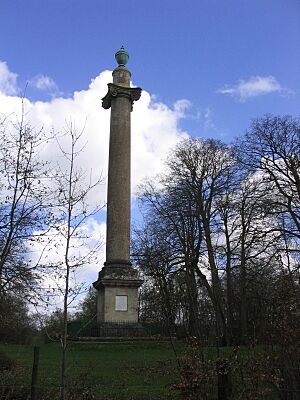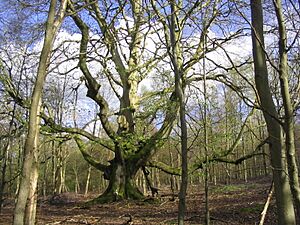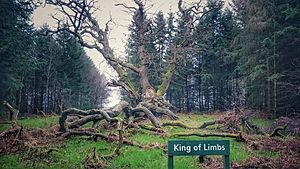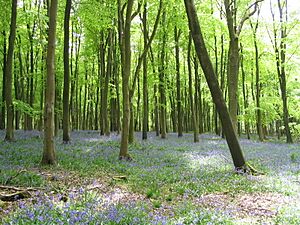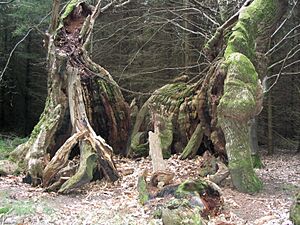Savernake Forest facts for kids
Savernake Forest is an amazing ancient woodland in Wiltshire, England. It sits on a high, flat area of chalk rock between the towns of Marlborough and Great Bedwyn. The forest covers about 4,500 acres (18 km2; 7.0 sq mi), which is like having over 3,400 football fields!
Most of Savernake Forest is in the small area called Savernake. What makes it special is that it's the only privately owned forest in Britain. It belongs to the Earl of Cardigan and his son, Viscount Savernake. Since 1939, the Forestry Commission has helped manage the trees. To keep its private status, the forest is closed to the public just one day each year.
Contents
Discovering Savernake's Landscape
Savernake Forest has a hilly landscape with both dry and wet valleys. The valleys inside the forest are mostly dry. The ground here has special clay and flint deposits. This creates damp, heavy soils. These soils are perfect for growing lots of oak and beech trees. Some parts of the forest can be quite wet due to poor drainage.
A Journey Through Savernake's History
The first time Savernake was mentioned was way back in AD 934. King Athelstan wrote about a woodland called "Safernoc." After the Normans invaded England in 1066, the land became theirs.
Savernake as a Royal Forest
In the 12th century, Savernake became a royal forest. This meant it was a special area for the King to hunt. It was huge, covering about 150 square miles (390 km2)! Royal forests weren't just thick woods. They included woodlands, small groups of trees (called copses), shared land, and rough grassy areas.
Richard Esturmy was put in charge of this land after the Norman Conquest. Since then, the Savernake estate and forest have been passed down through the same family. For over a thousand years, it has never been bought or sold. This makes it the only ancient forest in Britain still owned by a private family.
Kings, Queens, and Forest Wardens
One of the most exciting times for the forest was during the Tudor period. The head of the family, Sir John Seymour, often welcomed King Henry VIII to the forest. King Henry loved to hunt deer there. In 1535, King Henry stayed at Savernake. It's believed he met John Seymour's daughter, Jane Seymour, there. After his previous wife, Anne Boleyn, was executed in 1536, Henry married Jane. She became Queen just a few months later! This made the head of the Savernake family Henry VIII's father-in-law.
Jane Seymour sadly died when giving birth. Ten years later, King Henry also passed away. Jane's brother, Edward Seymour, 1st Duke of Somerset, then left Savernake Forest in 1547. He went to Hampton Court and became 'Lord Protector'. This meant he was like the King of England for five years. He ruled while his young nephew, Edward VI, grew old enough to rule on his own.
Changes to the Forest Over Time
From the mid-1600s to the mid-1700s, the forest changed in size. Some parts were turned into farmland. This was called dis-parking. During this time, royal officers were worried about the forest. They found "but 3 or 4 trees fit for his [the king's] use." The open areas were full of "heath, furze, fern [bracken]" and had "coarse turfe."
The final "dis-parking" of England's old deer parks happened during the Battle of the Atlantic (starting in 1940). This was because Britain needed to grow more food during the war.
Grand Avenues and Guinness Records
Another great time for the forest was when Charles Bruce and his nephew Thomas Bruce-Brudenell were in charge (from 1741 to 1814). Lord Thomas Bruce, 2nd Earl of Ailesbury was very successful. He became Governor to King George IV. The Bruce Tunnel, which carries the Kennet and Avon Canal under the estate, is named after him.
Lord Ailesbury hired a famous landscape designer named Capability Brown. Brown planted huge beech tree avenues in Savernake Forest. At that time, the forest was about 40,000 acres (160 km2), nearly ten times its current size! One of these is the Grand Avenue. It runs straight through the middle of the forest for 3.9 miles (6.3 km). This makes it the longest tree-lined avenue in Britain, listed in the Guinness Book of Records!
Two large stone structures were built around this time. One is a stone column, about 90 feet (27 m) high. Lord Ailesbury built it as a great viewpoint from Tottenham House.
World War II and Modern Management
Large parts of the forest were used as a place to store weapons between 1940 and 1949. After the war, new conifer trees were planted, but not too many. Today, the Forestry Commission is working to restore and protect the ancient trees. David Brudenell-Bruce, Earl of Cardigan is the current and thirty-first warden of Savernake Forest. Tottenham House, a very old and important building, was sold in 2014.
Exploring Inside the Forest
The Savernake Plateau is mostly covered by broad-leaved woodlands. It's also mixed with farmland. This area is part of the North Wessex Downs Area of Outstanding Natural Beauty.
East of Savernake, the landscape is a mix of farmland and forest. This creates a unique and "secret" landscape. Capability Brown planned how to connect different parts of the forest. He linked small groups of trees with oak plantings. He lined forest paths with beech trees. He also created open views with "proper objects" for the eye to rest on. He wanted the forest to feel like one big, beautiful park.
Later, a warden named George Frederick wanted to show off his forest. He rearranged tree groups and views. He also made grassy paths so visitors could see the woods better. He ordered the entire estate to be fenced. He also put fences around individual trees. This allowed the deer to roam freely without causing too much damage.
The fifth marquess realized the woodlands needed to make money. He planted 778,000 trees, including many softwoods, outside the forest's main area. He was the first in his family to start managing the larch and spruce plantations in a planned way.
Chandos Bruce, the sixth marquess, tried to continue this mix of planned management and caring for the forest's beauty. But it became too hard due to rising costs, taxes, and a lack of workers after World War I. In 1930, he talked to the government's Forestry Commission. He worried that giving up control would mean too many straight conifer trees would be planted. Eight years later, the commission agreed to his special conditions. They understood that using the forest for fun was as important as making money. So, after 800 years, the family gave up control. Thanks to Lord Ailesbury's dedication, the public gained a wonderful place to enjoy.
Ancient Trees and Woodland Life
Savernake is an Ancient woodland. It's a "coppice-with-standards" forest. A coppice is where broad-leaved trees, like hazel, grow from old stumps. Standards are trees allowed to grow tall and mature. If trees grow close together, they grow straight. If they have more space, their side branches grow large.
In the past, straight trees weren't always needed. Shipbuilders and furniture makers needed curved and oddly shaped pieces. These came from the side branches. Trees like beech and oak can be pollarded. This means cutting a standard tree about two-thirds up its trunk. Many branches then grow from the cut point. This helps the tree live longer and often creates curved pieces of wood. These pollarded trees become huge and live for many generations. Their main trunks grow very wide. Sometimes, heavy side branches break off in storms. Other times, the weight of the branches tears the lower trunk apart. This creates a large hole inside the tree over many years.
The oldest of these pollarded trees is the "Big Belly Oak." It's next to the A346 road. Big Belly is one of Fifty Great British Trees. It was honored during the Queen's Golden Jubilee. It has a trunk that is 11 metres (36 ft) around and is 1000–1100 years old! In 2001, it was in danger of splitting in half. This had already happened to the similarly old Duke's Vaunt tree. To save it, the Big Belly Oak was fitted with a metal "corset." The 2011 Radiohead album The King of Limbs is named after the ancient King of Limbs tree in the forest. The band even recorded part of their previous album, In Rainbows, near Tottenham House.
It's believed that nowhere else in Europe has so many "veteran" trees. Savernake has hundreds of these old beech and oak trees. Some stand alone, others are in avenues. Some are among younger trees, and some are in conifer plantations. Some important historical trees are named on local maps. Since about 2006, the Forestry Commission has been clearing space around these old trees. They also put up green plaques with their names. Other clearings have been made, showing old ponds that were hidden by conifer trees. Now, light can reach them. Standing water is very important for different kinds of plants and animals. Savernake has damp soil, but no streams. Another good practice is to leave dead wood lying on the ground. This helps small creatures like insects. In Savernake, fallen trees are left to decay. Dead standing trees (monoliths) are also usually left alone.
In 2003, White Park cattle were brought into Savernake Forest. They graze freely in the Red Vein Bottom area. This area is a mix of open land and old woodland pasture. It hadn't been grazed for over 60 years. This controlled grazing helps create open clearings. These are perfect for the ancient oak and beech trees. They also help rare lichens, fungi, and woodland plants grow. These are the special wildlife features for which Savernake Forest is named a Site of Special Scientific Interest.
Sites of Special Scientific Interest (SSSIs) are checked regularly to see how healthy they are. Savernake has SSSI status mainly because of the rare lichens found on the bark of its older trees. There are also many types of fungi and mosses. The overall health of Savernake is improving. This is partly because of the damage during World War II and possibly from air pollution. The site is currently rated as "unfavorable recovering." This doesn't mean the forest isn't beautiful. It's a statement about the health of the lichens, mosses, and small creatures.
Exploring Savernake's Paths and Features
Savernake Forest has many named roads and interesting spots. You can find them on the Ordnance Survey Explorer map 157 Marlborough & Savernake Forest. However, not many of them are named on the ground itself.
From Postern Hill to Amity Oak
This route goes about 3 miles (4.8 km) from west to east. Postern Hill is the highest point of the chalk plateau at 193 metres (633 ft). From here, you can look down over Marlborough. On the hilltop, there's a small Forestry Commission Camp Site called Postern Hill Campsite. It also has a public car park and a barbecue area. Four paths go south through the oak forest. The main one is Long Harry. This path goes down slowly, crossing White Road. The trees aren't too dense here, and there are many ancient oaks. One is called Saddle Oak because its branches are almost flat, like a saddle.
Next, you cross Church Walk, a path for horses and walkers. Then you reach Great Lodge Bottom. This is a dry valley that runs east. It's quite open with hawthorn and blackthorn bushes. After crossing the Grand Avenue, the valley turns into Red Vein Bottom. This area has rough grass and rabbit burrows. A small valley from the pinetum (a collection of pine trees) at Braydon Hook joins the path. The path from Red Vein Bottom goes around the Ashdale Firs. It passes some huge beech trees before reaching the Amity Oak. This old tree marks a parish boundary. The valley continues east towards Hungerford.
From Leigh Hill to Crabtree Cottages
This route also goes about 3 miles (4.8 km) from west to east. Leigh Hill is 2.8 miles (4.5 km) south of Postern Hill and is also 193 metres (633 ft) high.
There's a car park nearby that's open during certain seasons. Three small valleys run northeast from this high point. Postwives Walk starts with an old avenue of oaks. It gently goes down to cross Charcoal Burners Road (where charcoal is still made). It then continues to the heart of the forest, passing both the Queen Oak and the King Oak. A second valley, called Cheval Bottom, starts in an avenue of mature copper beeches. It passes beside the Park Pale. This is an old bank and ditch that once marked the edge of the Royal Park. The third valley starts near the column at Three Oak Hill Drive. Despite its name, this area has beautiful stands of beech and Scots pine trees. The ground goes down into Drury Lane and passes a young plantation. It then joins the other two valleys. As a wide, shallow valley of meadow, it passes Savernake Lodge on its way to Crabtree Cottages. From there, it goes to Little Frith, which is covered in bluebells in May. Finally, it joins the valley leading to Hungerford.
From Grand Avenue to Strawgrove Copse
This route stretches about 5+3⁄4 miles (9.3 km) from north to south. The Grand Avenue is a straight, narrow paved road. It connects the A4 road to the Durley Road near Tottenham House. It's lined with beech trees, but most of them are not from the original plantings. The A4 used to be a toll road through the forest for traffic between Marlborough and Hungerford. The Toll Road House still stands today. The Grand Avenue continues southeast to Eight Walks. This is where Capability Brown designed a hub with eight roads spreading out like spokes on a wheel. A little further on, there's a mysterious Monument on the west side of the road. People say it might be a marker or a tomb for someone who fell fatally from a horse.
At the Three Oak Hill Drive crossroads, a path northeast leads to Birch Copse. The Duke's Vaunt Oak is a famous tree, about 1,000 years old. It used to be hollow and 30 feet (9.1 m) around. In 1760, it even had a door and a lock and could shelter "twenty boys"! The tree is badly split now but is still alive. The ground here is damp, and parts of Birch Copse don't get much sunlight. While some tall pines look old, other plantation firs are green and healthy. Many kinds of fungi can be seen in October, and dead-wood fungi are common all year. At the southeast edge of the forest, there are good examples of Sweet Chestnut and Yew trees. At Holt Pound, an avenue of oaks connects Birch Copse to Bedwyn Common. This part of Savernake has its own avenue, London Ride. It runs for 1+1⁄3 miles (2.1 km) from St Katherine's Church to Upper Horsehall Hill Farm. The ride is lined with oak trees in the south and limes in the north. Many old oaks and sweet chestnut trees are still standing, and foxgloves grow at the forest edges. Forest paths and bridleways lead southeast. This area is very much a mix of forest and farmland. When you reach Stock Common, there are paths to Shawgrove Copse, which is near Great Bedwyn, or south to the back of Tottenham Park by way of Bloxham Lodge.
Nearby Places to Explore
- Marlborough, Wiltshire
- Cadley
- Burbage, Wiltshire
- Durley, Wiltshire
- Chisbury
- Great Bedwyn
- Little Bedwyn
- West Woods
- Collingbourne Woods
- Pewsey
- Wootton Rivers
- Easton Royal
- Wolfhall



